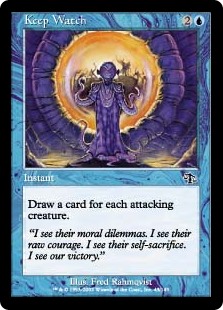Welcome back to week four of Monday Magic: COVID Edition. It has been 65 days since my last summoning. In some ways that number feels more like 482 days, as the pandemic rages on. We are slowly reaching the point where some people in these parts have begun seeing others in a socially distant manner, but we aren’t quite yet at the point where sitting at the same table for a game is a justifiable risk – though there are certainly some parts of the populace who are more cavalier about such prospects.
Despite these days without end, diving into the world of Magic: the Gathering has not been particularly enervating. For one, like most games, the enthusiasm comes from actually, you know, playing them. I could take extensively about Arkham Horror or Sentinels of the Multiverse in conversation, sure, but diving into game design, strategic planning, or reminiscing about past playthroughs doesn’t encompass the same sense of satisfaction that chucking dice to, dispensing damage, or drawing cards does in the moment.
Interestingly enough, however, card draw is what brings us to this week’s card pick.
In truth, this card has been one that has had sort of the opposite problem as those of the last few weeks. The last few card highlights were specifically those that I’ve personally wanted to include in EDH decks but haven’t had the luxury of doing so, though with each I’d originally jotted down a framework of an article idea around them – even if I decided to dispense with them of late.
This one, on the other hand, is quite the reverse. That is, this is a card that I have used in multiplayer for years with great effect. The problem that’s arisen time after time is that…it’s kind of hard to make an interesting article about such a basic game effect as spell-based card draw. Because of this, it’s sat on the list to talk about for well over a year while I’ve tried to come up with a worthwhile means of conveyance. But since I’ve been using this interim period to champion cards I’ve wanted to discuss carte blanche, this seemed as a good a window as any.
Card draw in Blue is about as baseline to its color identity as damage is to Red. It’s been a mainstay of the color since its very inception, and pretty every set has a card or four that let’s you draw additional cards in some form – it’s pretty much a requirement to set design. With so many variations on the same effect, unless it’s particularly splashy, it can be a little challenging talking about them in a way that seems interesting or clever.
And this one…is anything but splashy.
For what it does, though, it’s incredibly worthwhile – and incredibly overlooked.
Today we have: Keep Watch

Name: Keep Watch
Edition: Judgment / Planechase
Rarity: Common
Focus: Card Draw
Highlights: As a rule, Magic’s most effective card draw spells are those that disrupt the inherent balance betweetn speed, efficacy, and cost. Generally speaking, the baseline formula for card draw spells is usually ‘N mana for N-1 cards, at sorcery speed’ (e.g. Divination). Drawing more cards means spending more mana. Likewise, giving the card instant speed also either requires you increase the cost (e.g. Inspiration), or add some kind of downside to offset it (e.g. Catalog). It’s a pretty standard template. Which is why whenever a card deviates significantly, it almost always becomes notable.
As a three mana instant speed draw spell, Keep Watch opted for the downside rider part of the equation, mandating that its card draw is only worthwhile casting during combat. Which means that if you’re wanting to draw for something specific during the main phases of the game, it’s not the most ideal choice, sure. On the other hand, if you are merely after raw card draw potential, its timing restriction is well worth putting up with. Because there are not that many other cheap card draw options that can give you a better bang for your buck than this one.
In the case of Keep Watch, it states that you get to draw a card for each attacking creature. Pretty simple. Even in Commander, attacking with three or more creatures is not at all uncommon (even more so if you’re facing token decks), which means that unless you use it in a pinch for a single card or two (which still makes for a better ROI than your baseline options), you’re easily going to be able to restock your hand for minimal effort.
Moreover, this card only specifies that the creatures must be attacking. No where does it say that you have to be the one being attacked. Quite the opposite: Keep Watch can also be used if you’re the one on the offense, or as can often happen in Commander, if you’re not even directly involved in the combat at all. Indeed, it can be highly advantageous for your own purposes to draw off of other players fighting each other – though you can get some occasional side eye in the process.
Yes, though it doesn’t have a flashy presence or pedigree, Keep Watch is a card draw option that simply thrives in multiplayer settings. It only does one thing, but it does it incredibly well. And as a common, no less.
Keep an eye out for us to be regularly featuring other more accessible-but-worth-it Commander cards going forward. In the meantime, we’ll keep the light on for you.
![]()
You can discuss this article over on our social media!
